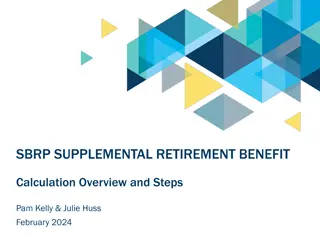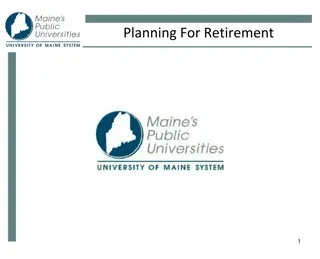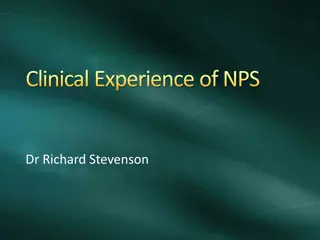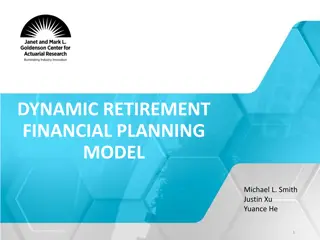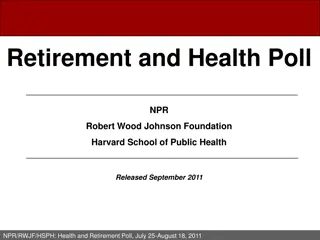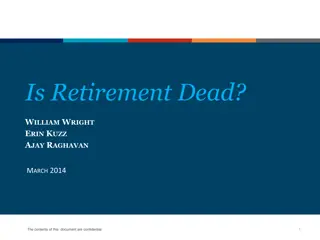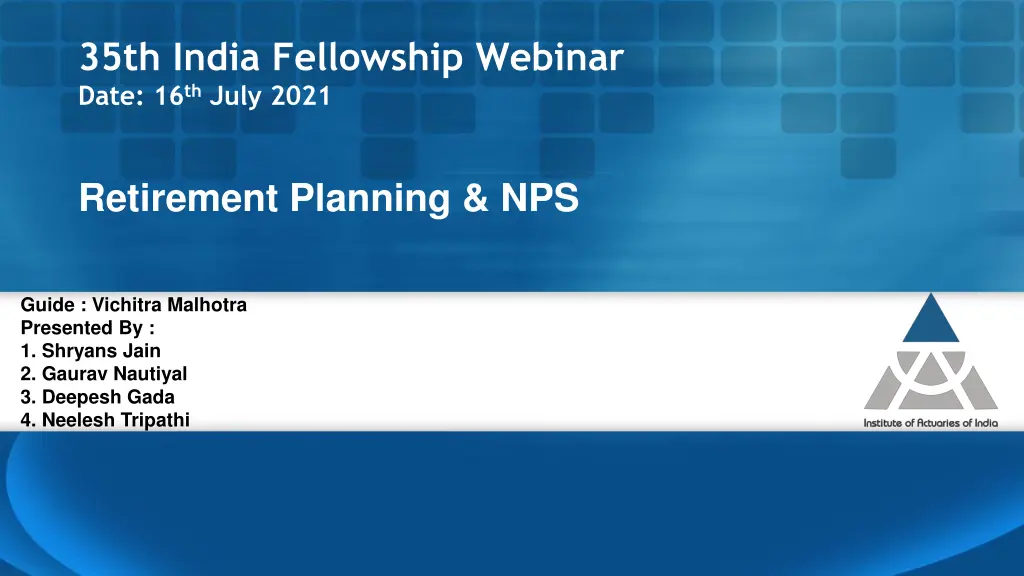
Retirement Planning Guide - NPS, Gratuity Benefits & More
Explore the essential aspects of retirement planning, including the National Pension System (NPS), Gratuity benefits, and mandatory schemes like Provident Fund. Learn about the key considerations, investment strategies, and stakeholders involved in securing a comfortable retirement. Join the discussion on preparing for a financially stable and stress-free post-retirement lifestyle.
Download Presentation

Please find below an Image/Link to download the presentation.
The content on the website is provided AS IS for your information and personal use only. It may not be sold, licensed, or shared on other websites without obtaining consent from the author. If you encounter any issues during the download, it is possible that the publisher has removed the file from their server.
You are allowed to download the files provided on this website for personal or commercial use, subject to the condition that they are used lawfully. All files are the property of their respective owners.
The content on the website is provided AS IS for your information and personal use only. It may not be sold, licensed, or shared on other websites without obtaining consent from the author.
E N D
Presentation Transcript
35th India Fellowship Webinar Date: 16thJuly 2021 Retirement Planning & NPS Guide : Vichitra Malhotra Presented By : 1. Shryans Jain 2. Gaurav Nautiyal 3. Deepesh Gada 4. Neelesh Tripathi
Introduction of Guide Vichitra Malhotra Vichitra Malhotra is Founder and Consulting Actuary for Veritas Actuaries and Consultants Vichitra Malhotra is a Consulting Actuary with about 10 years of work experience, providing consultancy in various actuarial practice areas. She is qualified from both Institute of Actuaries of India as well as Institute and Faculty of Actuaries, UK. In her past role, she has worked with large multinationals in India including PricewaterhouseCoopers (PwC), Max Life Insurance and Canara HSBC OBC Life Insurance. www.actuariesindia.org
Introduction to Case Study A Company would like to conduct a series of awareness sessions for its employees to highlight the key retirement benefits available in the corporate sector and to emphasize on the importance of retirement savings. The schemes offered by the Company are Gratuity benefit, Provident Fund and National Pension System (NPS). The contribution to NPS is optional. www.actuariesindia.org
Todays discussion Introduction of Guide Introduction to case study Retirement Planning Why? Overview of Retirement benefits in India National Pension scheme- A social security initiative NPS Stakeholders Choosing an investment strategy Projection of benefits and income www.actuariesindia.org
Retirement Planning Why? Medical Inflation Pattern of spending changes post retirement Nuclear families No state sponsored pension Plan your Retirement so you can manage your Lifestyle from Pre to Post Retirement. Prepare for more free time and less stress! www.actuariesindia.org
Mandatory Schemes Gratuity Governed by Payment of Gratuity Act, 1972. Code on Social Security 2020 to subsume nine Labour Acts related to social security (including Payment of Gratuity Act, 1972). Gratuity is sum of money paid by an employer to its employee at the end of the employment period as mark of recognition for contributing to the company. Applicability Every establishment having 10 or more employees on any day in the preceding 12 months Eligibility Only after completing 5 years of service with same employer Benefit Payable (15/26) * Salary(Basic + DA) * Service Benefit amount is capped at INR 20 lakhs It is payable On superannuation or retirement On resignation or termination On death or disablement due to accident or disease (even if service is less than 5 years) www.actuariesindia.org
Mandatory Schemes Employees Provident Fund Governed by Employees Provident Fund and Miscellaneous Provisions Act, 1952. Code on Social Security 2020 to subsume nine Labour Acts related to social security. Applicability Every establishment having 20 or more employees It is a statutory benefit payable as lump sum. Funding Employee contribution 12% of salary (Basic + DA) Employer contribution 3.67% of salary (Basic + DA) Interest is credited on employer and employee contributions. It is payable on On superannuation or retirement Unemployed for period of 2 months or more Death in service Partial withdrawals are also allowed (educational opportunity, marriage, repayment of home loan, etc.) Tax treatment EEE (Exempt, Exempt, Exempt) www.actuariesindia.org
Mandatory Schemes Employees Pension Scheme Governed by Employees Provident Fund and Miscellaneous Provisions Act, 1952. Code on Social Security 2020 to subsume nine Labour Acts related to social security. Applicability Every establishment having 20 or more employees It is a statutory benefit payable as pension. Funding Employee contribution Not required Employer contribution 8.33% of salary (Basic + DA) capped at INR 15,000 i.e. maximum contribution of INR 1,250 per month Benefit Payable (Pensionable Salary * Pensionable Service)/70 Pensionable salary Average of last 60 months drawn salary Pensionable service Service after 16th November 1995 Pension subject to minimum of INR 1,000 per month It is payable on On superannuation or retirement Early retirement available from age 50 and must have completed 10 years of service. Death in service Pension is available to widow/widower if at least one month contribution have been paid www.actuariesindia.org
Overview of retirement benefits in India Mandatory Scheme Gratuity Employees Provident Fund Employees Pension scheme Non Mandatory Popular schemes Public Provident Fund National Pension Scheme (NPS) Individual Investments Private Pension plan Personal savings Property investment Employer Schemes Superannuation Post Retirement Medical Defined Benefit Pension www.actuariesindia.org
National Pension scheme- A social security initiative Initiative by Government of India in 2004 Falls under the purview of the Pension Fund Regulatory and Development Authority (PFRDA) and Central Government Voluntary and long-term investment mechanism for retirement income Open to employees from the public, private and even the unorganised sectors Encourages investment in a pension account at regular intervals during the period of employment After retirement, the subscribers can take out a certain percentage of the corpus Remaining amount is received as a monthly pension www.actuariesindia.org
NPS Stakeholders NPS Trust Trustee Bank PFRDA NPS Subscribers Pension Fund Managers Points of Presence Central Recordkeeping Agency Annuity Service Providers www.actuariesindia.org
NPS Stakeholders NPS subscriber person who open their NPS account and contribute money Point of Presence (PoP) first point of interaction between NPS subscriber and NPS architecture Central Recordkeeping Agency (CRA) recordkeeping, administration and customer service functions for all subscribers are handled by CRA Pension fund managers (PFM) they manage retirement savings under NPS www.actuariesindia.org
NPS Stakeholders Trustee Bank Facilitates fund transfer across various entities of NPS system viz. subscribers, PFMs, ASPs Annuity Service Providers (ASP) Responsible for delivering regular monthly pension after subscriber exits from NPS NPS Trust Responsible for taking care of funds under the NPS in the best interest of subscribers Pension Fund Regulatory and Development Authority (PFRDA) An autonomous body set up by Government of India to develop and regulate pension market in India. www.actuariesindia.org
Features and Benefits NPS is an excellent retirement product in terms of transparency, access, cost and tax benefits. Genuine security Net post retirement - Restrictions on withdrawal from tier-I account and stipulation that at maturity part of the tier-I corpus be used to buy annuity Higher expected returns compared to other traditional tax-saving investments like the PPF Market linked investments in debt and equity instruments Portability across jobs and locations, with tax benefits under Section 80C and Section 80CCD Benefits are less certain compared to the Earlier Pensions Schemes -the Defined pension related benefits for Government Employees www.actuariesindia.org
Eligibility Norms and procedures A citizen of India, whether resident or non-resident or an OCI /PIO can join NPS The subscriber should be between 18 and 65 years old on the date of submission of application The subscribers should comply with the Know Your Customer (KYC) norms as detailed in the subscriber registration form. Should not be Un-discharged insolvent and individuals of unsound mind. Both an online as well as an offline route to open the NPS account and generate a Permanent Retirement Account Number(PRAN) PRAN is a unique 12-digit number assigned to the registered subscribers. Using PRAN the NPS Login can be made through different channels www.actuariesindia.org
Two types of NPS accounts - TIER 1 and TIER 2 Tier I : The primary account, a pension account Has restrictions on withdrawals and utilization of accumulated corpus. The tax breaks that NPS offers are applicable only to Tier I accounts. Tier II: An investment account, similar to a mutual fund in characteristics, but offers no Exit load, no commissions, good returns Helps bring liquidity to the scheme, subscribers with pre-existing Tier I accounts can deposit and withdraw monies as and when they want The Tier 2 NPS account offers tax benefits to government employees under certain conditions. www.actuariesindia.org
Taxation benefits Any person who is a subscriber of NPS can avail tax deduction up to 10 percent of gross income within the overall ceiling of Rs 1.5 lakh, under Section 80C of the Income Tax (I-T) Act Any additional self contribution (up to Rs 50,000) under section 80CCD(1B) as NPS tax benefit. The scheme, therefore, allows a tax deduction of up to Rs 2 lakh in total. Similar to PPF/ EPF , the NPS is an EEE (Exempt-Exempt-Exempt) instrument where the entire corpus escapes tax at maturity and entire pension withdrawal amount is tax-free. www.actuariesindia.org
Withdrawal and Exit rules Out of the entire corpus of the NPS scheme at retirement, Beneficiary to keep aside at least 40% of the corpus to receive a regular pension from a PFRDA-registered insurance firm. After an investment period for at least three years, subscriber may withdraw up to 25% for certain purposes. These include children s wedding or higher studies, building/buying a house or medical treatment of self/family, among others. Withdrawal can be done up to three times (with a gap of five years) in the entire tenure. These restrictions are only imposed on tier I accounts and not on tier II accounts. www.actuariesindia.org
NPS Investment Options Auto Choice Option for those who do not have required knowledge to manage their NPS investments Decides the risk profile of investments as per subscriber age. At older ages, investment mix turns more stable and less risky. Investments are made in a life cycle fund with proportions invested in different asset classes pre-determined which is dependent on age. There are 3 life cycle funds to choose from: o Moderate Life Cycle Fund (default option) caps the equity exposure to a maximum of 50%. o Aggressive Life Cycle Fund caps the equity exposure to a maximum of 75% o Conservative Life Cycle Fund caps the equity exposure to a maximum of 25% www.actuariesindia.org
NPS Investment Options Active Choice Option for those who wish to decide asset allocation on their own. Four asset classes are available: o Asset Class E (Equity) maximum equity allocation is capped at 75% up to the age of 50. Thereafter maximum equity allocation will reduce by 2.5% each year till age of 60 o Asset Class C (Corporate Debt) can allocate up to 100% of contribution amount o Asset Class G (Government Bonds) can allocate up to 100% of contribution amount o Asset Class A (Alternative Investment Funds, MBS, REITs) can allocate up to 5% of contribution amount www.actuariesindia.org
Considerations to be borne in mind while choosing investment strategy Need to balance conflicting objectives of safety of capital and achieving reasonably high long term returns Need for returns to be at least as much as inflation Age a younger person can take on more investment risk Diversification helps to reduce specific risk related to a particular asset class www.actuariesindia.org
Considerations to be borne in mind while choosing investment strategy Risk Appetite Expertise NPS investment should be done keeping in mind overall retirement portfolio. www.actuariesindia.org
Projection of retirement corpus Assumption which will have impact in accumulated retirement corpus Age at entry Retirement Age Contribution Rate Expected Return on Asset (EROA) Salary increase assumption (If contribution is based on projected salary) Various Charges by intermediaries e.g. Asset Servicing charges, Investment Management Fee, Reimbursement of Expenses etc. Taxes Inflation for wage ceiling in EPF/EPS Ignored Gratuity Benefit under retirement corpus. www.actuariesindia.org
Projection of retirement corpus Assumptions under Base Scenario Assumption Entry Age Retirement Age Contribution rate: EROA Monthly Basic Salary at Age 25 CTC Salary Increase Rate Annuity Rate for Single Life Annuity payable monthly Amount Converted to Annuity Inflation Taxes Value 25 Years 60 Years 20% of Basic Salary (10% of CTC) 9% Per Annum net of all charges INR 40,000 2 x Basic Salary 7% Per Annum 7.5% 100% 6% 0% www.actuariesindia.org
Projection of NPS corpus Sensitivity of NPS Corpus with +/- 5% of contribution rate in Base Scenario Accumulated value under different contribution rate scenario 7.00 Cr 6.56 Cr 6.00 Cr 5.21 Cr 5.00 Cr Base Scenario 4.00 Cr 3.93 Cr Contribution +5% 3.00 Cr Contribution -5% 2.00 Cr 1.00 Cr .00 Cr 25 30 35 40 45 50 55 60 Age www.actuariesindia.org
Projection of NPS corpus Sensitivity of NPS Corpus with +/- 2% of EROA in Base Scenario Accumulated value under different investment return scenario 9.00 Cr 8.00 Cr 7.84 Cr 7.00 Cr 6.00 Cr Base Scenario 5.21 Cr 5.00 Cr EROA +2% EROA -2% 4.00 Cr 3.59 Cr 3.00 Cr 2.00 Cr 1.00 Cr .00 Cr 25 30 35 40 45 50 55 60 Age www.actuariesindia.org
Projection of NPS corpus Retirement Corpus at different entry ages to NPS Accumulated value for entry at different ages 6.00 Cr 25, 5.21 5.00 Cr 30, 4.20 4.00 Cr 35, 3.29 Base 3.00 Cr 40, 2.48 2.00 Cr 45, 1.75 50, 1.10 1.00 Cr 55, 0.52 .00 Cr 60, - 25 30 35 40 45 50 55 60 Age www.actuariesindia.org
Projection of EPF corpus Sensitivity of EPF Corpus with +/- 5% of contribution rate in Base Scenario Accumulated value under different contribution rate scenario 7.00 Cr 6.00 Cr 5.66 Cr 5.00 Cr 4.58 Cr Base Scenario 4.00 Cr Contribution +5% 3.00 Cr 2.00 Cr 1.00 Cr .00 Cr 25 30 35 40 45 50 55 60 Age www.actuariesindia.org
Projection of EPF corpus Sensitivity of EPF Corpus with +/- 2% of EROA in Base Scenario Accumulated value under different investment return scenario 8.00 Cr 7.00 Cr 6.76 Cr 6.00 Cr 5.00 Cr Base Scenario 4.58 Cr EROA +2% 4.00 Cr EROA -2% 3.23 Cr 3.00 Cr 2.00 Cr 1.00 Cr .00 Cr 25 30 35 40 45 50 55 60 Age www.actuariesindia.org
Net Replacement Ratio Net Replacement ratio of CTC at age 60 by NPS, EPS and EPF 140% 120% Net Replacement Ratio (NRR): 7% 100% 7% Post tax income after retirement / Post tax income before retirement 49% 80% EPS 7% 41% EPF 7% 60% NPS 34% 7% 34% 40% 24% 57% 48% 20% 38% 29% 26% 0% Base Case NPS and EPF Employee Contribution rate +5% NPS Contribution rate -5% EROA +2% EROA -2% www.actuariesindia.org
Net Replacement Ratio Required NPS contributions for 80% NRR of CTC with different entry ages in base scenario 120% 103.01% 100% Required contribution as a percentage of CTC 80% 60% 48.68% 40% 30.64% 21.67% 16.33% 20% 12.81% 10.33% 0% 25 30 35 40 45 50 55 Age www.actuariesindia.org
Projection of retirement corpus Limitation of the projection of retirement corpus The value of retirement corpus is degraded by inflation, all the estimated accumulation of corpuses are not adjusted for inflation. Taxes assumed as 0%, It impacts the contribution amount and Post retirement income after tax. Retirement Age assumed 60, though many may decide to retire early or late. Expected return may vary a lot as the projection period is very long. Annuity rate is dependant on interest rate & mortality. Interest rate may change significantly over years. Sensitivity of net replacement ratio to annuity rate is not performed Expenses may change over time. Complete annuitisation of corpus may not be most tax efficient and favorable among the subscriber. www.actuariesindia.org

